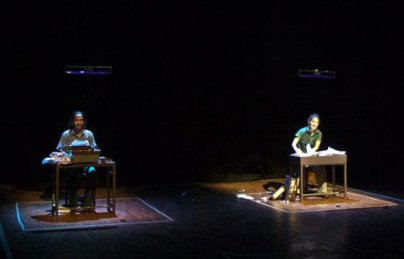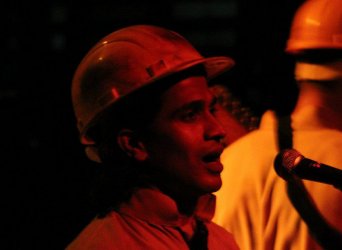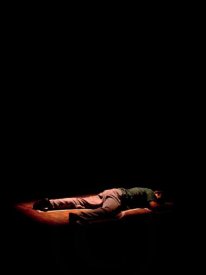
|   |

|   |
A play of unending queries - Renu Ramanath e-mail: renuramanath@hotmail.com October 26, 2012 As the last light fades out into darkness over the finally still form of an actor lying down sprawled, immobolised, and within the contours of a body drawn on the floor, we realise that the play has not ended. That this is not the end. But that it has only started to happen again and again within the minds of the viewers. ‘After the Silence’ is not a play that leaves behind a good feeling, in the conventional sense. There is no feel-good factor. It leaves behind residues. Residues of unrest. Of doubts. And questions. As we take leave, the unrelenting intonation of “Wake Up!” continues to resonate somewhere within. This is a play that oscillates between lightning speed and meditative slowness. It unsettles and disturbs. It throws up questions, and never pauses for an answer. What is life? What is death? What is dream? What is reality? Who is a dreamer? Who is awake? Is life just the small shards of reality scattered between slices of dreams? Or is it just a dream, disturbed / distracted in between by flashes of reality, of waking up? Is it just a forced compilation of meaningless routine? Will you never wake up? Does every dream of waking up lead only into the labyrinth of another dream? Originally written and directed by the Chilean theatreperson Elias Cohen in 2001 to be staged with a two-person cast of Martin John C. and Manoj Mathai, then two students of the School of Drama, Thrissur, ‘After the Silence,’ was reproduced last year by Sadhana Centre for Creative Practice, Thrissur, with Martin John taking up the mantle of the director, casting himself and the Chilean theatreperson Valeria Olguin Espinoza. He is expertly supported by a team of experienced theatrepersons, drawn from various countries including the Chilean actor/musician Claudio Clavija, light designer Jose Koshy, dramaturge and actor Shaji Surendranath, Mumbai-based theatreperson Paresh Gosar, Argentinean performer Carla Gida Johnson and Sanandan, a young actor/musician from Thrissur. 

The play, opening to edgy music punctuated with the taps of an ancient typewriter, played live by the three or four performers who are barely revealed under the dim red light, progresses with briskness as the performers march forward, clanking and assembling metal pieces that quickly turn out to be the bare minimum property used throughout the entire play – two metal desks and stools. The assembling of stage property in front of the audience, maintaining a mechanical manner, provides an intimate space of interaction with the audience, yet sparks off a certain sense of consternation among the audience. Then, with the same efficiency, clinical precision and dead-pan faces, the team draw the contour of a body – a corpse – on the floor and one of the actors places herself within the lines.  Then, as suddenly as the music changes, a silence begins to pervade and the play as such, begins. We realise that what we were witnessing so far was the preparation of the performance space. There are only two actors – Actor I and Actor II, who transform at first into a Medical Student and a Corpse, and an Office Worker I and Office Worker II. What follows is a discourse on dream and reality, of oppression and escape, of monotony and change, presented through vigorous physical acting. The whole play is a fine sample of physical theatre that makes use of the actor’s body as the prime tool of expression. Body itself becomes the subject often.  At the end of a dizzying circle, the play returns to where it began. Actor II, in a perfect reversal of her frenetic opening movements, slowly returns to the contour of the corpse on the floor. It is darkness, and silence. The play is bi-lingual, oscillating between Malayalam and English. A wide range of sounds and noises, mostly mechanical like the taps of the typewriter or the ticking of the clock are weaved into the background score alongwith the music instruments and vocal singing, creating a strange and unsettling soundscape. The acting by Martin and Valeria is powerful and physical, often on the point of bursting with a restrained energy, especially the corpse-like convulsive movements of Valeria. The costume and property are minimal and precise, with scenic design by Usman Parudur, a young visual artist. With most of the team members having known and worked together with each other for years, there is a smooth and seamless flow of communication, imparting a flowing energy to the whole process. Of course, the energy levels vary from production to production, as could be expected of any theatre work and the three performances that I’d watched during the past one year (the last one was in August 2012 in Kochi), differed much on the energy levels and dynamics. This is a play that keeps changing and evolving. Perhaps that’s what gives rise to the magic of theatre, isn’t it? Renu Ramanath is a writer and columnist based in Kochi. She has covered art and culture extensively for The Hindu as a Staff Reporter in the Kochi bureau from 1996, writing reviews and features in The Hindu Friday Review and Sunday Magazine. Currently she edits Art Concerns, an online journal for contemporary Indian art. |